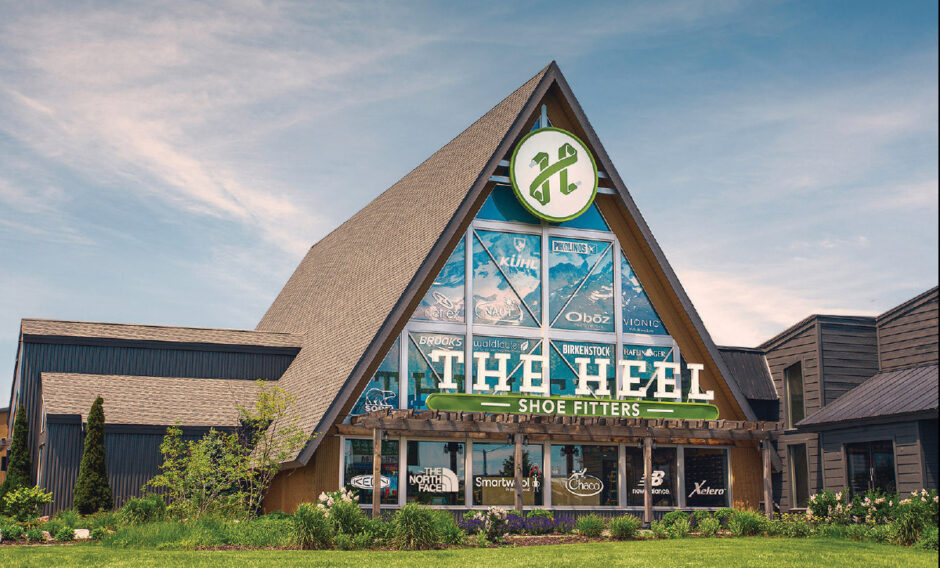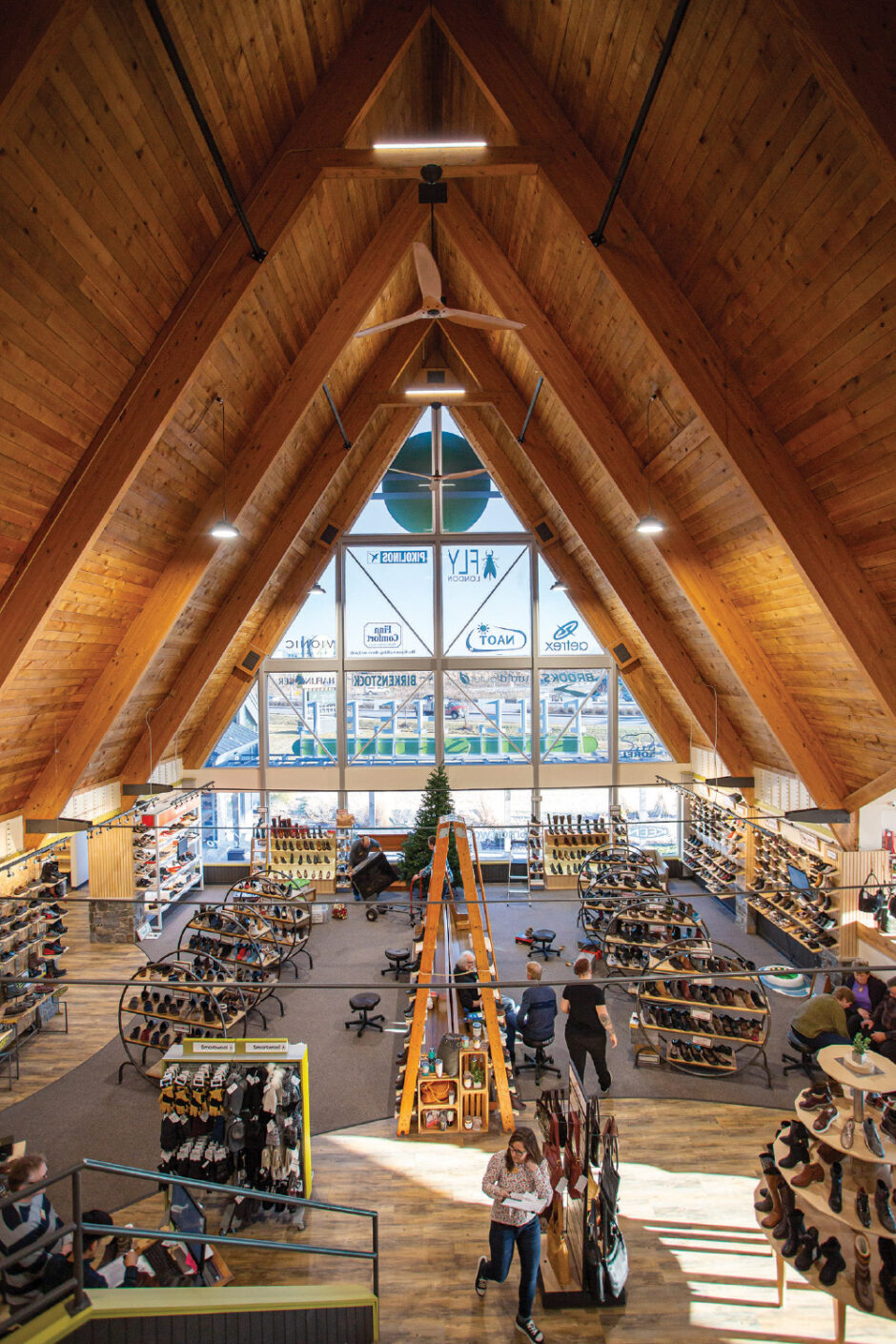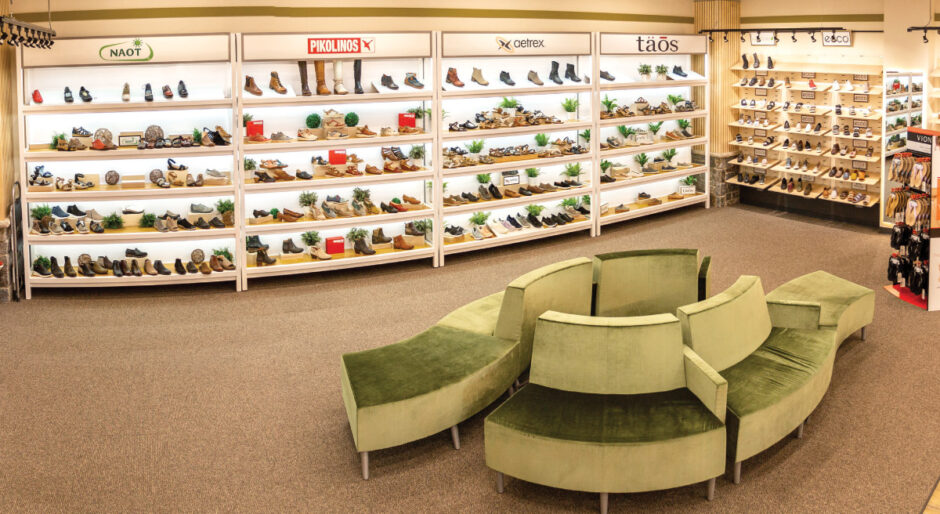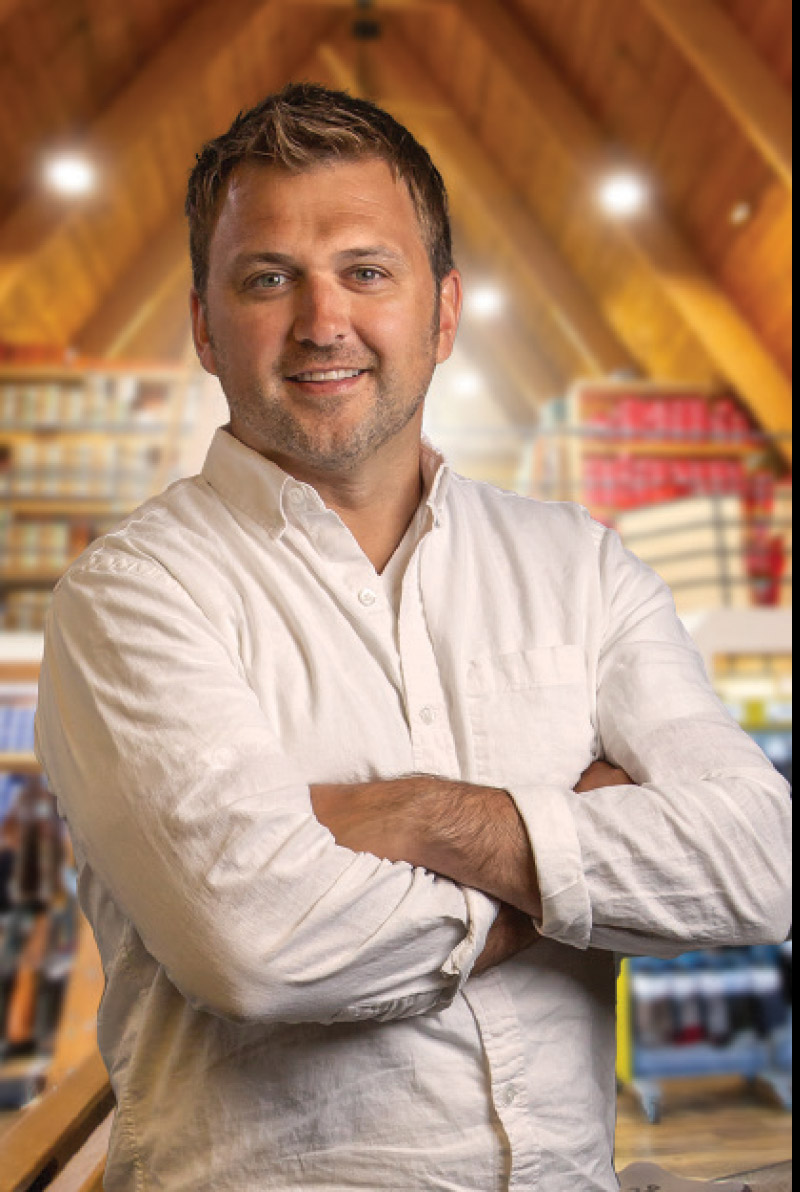 Exactly how does The Heel Shoe Fitters do it? How has the one-store, health-and-wellness format retailer in Green Bay, WI, increased sales by a multiple of 55 times since 2009? How is its formula—a huge inventory (approximately 100 brands and 70,000 pairs) coupled with a high level of customer service—profitable, let alone sustainable? How can a store stay open for limited hours on Saturdays (from 9 a.m. to 4 p.m.), close on Sundays and still get 80 percent of its revenue from in-store sales? Why is Owner Troy Dempsey, NSRA’s recent “Retailer of the Year” award recipient, confident that much more growth awaits in the years ahead—without plans to open additional locations? And how is all this possible in Green Bay, of all places?
Exactly how does The Heel Shoe Fitters do it? How has the one-store, health-and-wellness format retailer in Green Bay, WI, increased sales by a multiple of 55 times since 2009? How is its formula—a huge inventory (approximately 100 brands and 70,000 pairs) coupled with a high level of customer service—profitable, let alone sustainable? How can a store stay open for limited hours on Saturdays (from 9 a.m. to 4 p.m.), close on Sundays and still get 80 percent of its revenue from in-store sales? Why is Owner Troy Dempsey, NSRA’s recent “Retailer of the Year” award recipient, confident that much more growth awaits in the years ahead—without plans to open additional locations? And how is all this possible in Green Bay, of all places?
These are fair questions to ask. After all, the demographics surrounding The Heel Shoe Fitters (a.k.a. The Heel) don’t exactly scream explosive growth. The area is home to a relatively small population of about 300,000. The Heel’s heath-and-wellness customer base is even narrower: primarily 40 to 80 years old and heavily female. Green Bay is not a boom town, nor is it a fashion mecca, unless foam cheese headwear, camo print jumpsuits and snow boots are haute couture. That look is de rigueur for many of the 81,000-plus fans who cram into the famous Lambeau Field on often-frigid Sundays to cheer on their beloved Packers. The point? Area residents, by and large, are utilitarian in their sartorial needs. They aren’t known for conspicuous consumption when it comes to stocking their wardrobes.
Yet The Heel is rocking and rolling, led by its attention-grabbing, 50-foot, A-frame structure. (There’s an adjacent outlet store, warehouse and offices on site, totaling 28,000 square feet.) Located off a busy exit of U.S. Rte. 41, the unique structure and location have played key roles in the store’s success since it moved there in 2016.
“It gives a wow feeling the minute you walk in,” Dempsey says. “And I knew that all roads kind of lead through this location with upwards of 75,000 cars passing by daily.”
Matt Schwartz,, chief revenue officer for Aetrex, likens The Heel to a top-notch ski lodge in the Rockies. “The Heel is elite in its ability to create an emotional experience,” he says. “The visual merchandising is clean, the space is open, the layout of premium product is well thought-out and it’s easy to shop.”

That A-frame building, though, had serious bad juju to overcome. Several previous businesses didn’t last, including a ski shop, an outdoor goods store and, most recently, a bike shop. But Dempsey likes to go against the grain when it comes to conventional business wisdom. And he had several reasons for wanting to move The Heel to the unusual building, leaving its downtown area since 1970. First, he sought more accessible parking, believing it would help the business grow significantly.
“Parking had always been a challenge downtown, and because we specialize in solving a lot of foot-related problems, that goes hand in hand with the idea that you don’t want your customers to have to walk a long way,” Dempsey says. “Our own parking, outside our front door, has been a really important factor in our growth.”
Another incentive for the move was that the building offered room for The Heel to grow. It also housed four co-tenants to help cover the overhead as The Heel expanded, one departing tenant at a time. “We had control of the destiny of the building,” Dempsey says, adding that another 2,500 square feet could be converted to The Heel by joining its two buildings. He’s also prepared to build on another 5,000 to 7,000 square feet onto the main store. He’s that bullish on The Heel’s growth potential. In fact, he thinks The Heel has only scratched the surface of its local customer base. “I’d guess right now we gobble up five to 10 percent of the footwear market share of Green Bay, so there’s lots of room to take more,” Dempsey says. “I believe we can also draw people from further and further distances by providing a great experience.”
Dempsey has done the math: A regional population of 250,000 spending $250 per person in shoes annually amounts to $62.5 million. “That’s a pretty big number,” he says. “Of course, a lot of people buy shoes from Amazon, Zappos, Kohl’s, etc., but if you want to have a great experience, require help with a foot problem and don’t want to serve yourself, we’re that store. We’ve been slowly convincing people of the value of that shopping experience.”
There are other factors supporting The Heel’s continued growth—like the five-story regional surgery facility soon to open directly across the road. An estimated 430 people will work there, plus thousands of patients live within a two-hour radius and will pass through each year—many of whom could use properly fit footwear to help them recover and stay healthy. “In addition, people might bring a parent in to get hip replacement surgery and don’t want to wander too far off while they wait. They can spend an hour or so at The Heel,” Dempsey says.

Other neighbors include the new Kwik Trip gas/convenience store adjacent to The Heel and the Stein’s Garden & Home outpost across the street. The investments these businesses are making in the area convinced Dempsey to pour $450,000 into upgrading his parking lot, which is now fully concrete, features state-of-the-art drainage and includes infrastructure for electric vehicle charging stations. Dempsey is looking into arrangements that would allow The Heel to offer vehicle-charging coupons to customers who own electric vehicles. “We’d be a great place to hang around in for an hour while they charge their vehicles,” he surmises. “They can fill up their car with shoes as well. It’s all part of our experience, and I’m always thinking of ideas to improve upon that.”
One unique example of experiences The Heel offers is an Octoberfest promotion the retailer did with Birkenstock. The staff dressed in authentic lederhosen and German delicacies were served. David Kahan, CEO of Birkenstock Americas, reports that the event was a huge success. “This shop has far exceeded all our expectations,” he says, describing The Heel as one of the best single store locations in North America. “The Heel has a high degree of community engagement; they know their clientele and continually use creative tactics to drive traffic.” Kahan adds, “Troy Dempsey takes a forward-looking, creative thought process to the entire business. The only thing ‘old school’ is the high degree of service. He’s combined traditional sit-and-fit service with a great shopping experience.”
Bill Langrell, COO of Taos Footwear, says The Heel “doesn’t cheat” on the customer experience. “Their superior customer service is a huge reason why the business is so different than many others,” he says. “They are true problem-solvers and spend quality time with each customer learning what their needs and wants are in order to help them select the product that’s right for them.” Then there’s everything else, Langrell adds. “From the minute you drive into the parking lot, you know you are in a well put together store,” he says. “It only gets better when you walk in and see the wide variety of top brands displayed in a very eye-appealing way. The visuals of the whole operation and depth of product make this store so unique.”
Best in Shoes

Dempsey’s goal is to be “the best shoe store in the world.” And while that is an ever-rising bar, it serves as a north star for Dempsey and his 49 employees. It’s a labor of love for him, even though the pursuit can be taxing. “Oftentimes sales managers walk in and say, ‘This might just be the nicest shoe store I’ve ever seen.’ Meanwhile, I’m looking around thinking: I don’t like this, this or this, and we’ve got to change this, this and this,” he says. “I’m constantly challenging myself to make The Heel the best shoe store in the world, and while that’s not really measurable, our goal is to always keep improving.”
That effort starts the minute customers step out of their cars and onto The Heel’s new parking lot. Once inside, it’s the jaw-dropping selection, the prompt and best-in-class customer service and the follow-up thank you cards sent to customers. No detail is left to chance. The Heel’s “floor quarterback” greets customers and asks what their needs are. If there is a wait for service, the customer is entered into a cue, similar to the software restaurants use. While they browse, The Heel matches salespeople who align best with customers’ needs. This is a step beyond the deli counter method where customers take a ticket and are served by whatever salesperson calls out their number. “That doesn’t always match the right employee with the customer,” Dempsey says. “Whereas, if our customer is experiencing a foot problem, we’ll match them with one of our four staff pedorthists.” Matches can be more nuanced. “The conservative guy won’t be matched with our employee who may have purple hair and nose piercings,” Dempsey says. “Why make the encounter awkward?”
Dempsey aims for every customer interaction to be as pleasant, seamless and helpful as possible. As such, The Heel is a no upsell zone, and employees don’t work on commission. “Unlike other retailers where it’s push, push, push, I’ve found that the less you push, the more people tend to buy,” he says. The softer approach also increases the likelihood of repeat customers. “Shearing sheep, as opposed to skinning them, allows the wool to grow back,” he offers. “If customers buy what they’re comfortable and happy with—and had a pleasant shopping experience—they tend to come back.”
Dempsey, who is on the floor 50 percent of the time (upwards of 90 percent on Saturdays), leads by example in creating The Heel’s culture. “I make it clear to all my employees that my primary motivation is that every customer has a great experience,” he says. That includes the surly ones. In fact, Dempsey relishes the challenge of turning those frowns upside down. “I love helping the really difficult customers who come in disgruntled. I can help make them feel better,” he says. At the same time, Dempsey has his employees’ backs. He’s not afraid to “fire” customers who mistreat staff. “I’ll step in and tell that customer they must be respectful and, if they can’t, then they can’t be a customer here,” he says. “Often, that puts them off guard and changes their mood, but the attitude that the customer is always right is not part of our culture. Sometimes the customer isn’t right, and I think my employees appreciate that.”
Dempsey is a firm believer that a happy staff enhances The Heel’s shopping experience. Salaries are competitive and The Heel provides healthcare and a 401K plan. “I want to do that, but I also need to because I want long-term employees,” he says. “Good employees might stick around a few years, but they have to think about their long-term needs. They want a job that will provide for a good retirement.” Dempsey says salary remains a work in progress. “I’d love to get to the point where all employees who are committed to our mission are earning a very comfortable living wage,” he says. “Many already are, but we have room to grow on that.”
The process starts by finding good hires, which isn’t easy. “We’re always recruiting,” Dempsey says. “Wherever we go, whomever we meet, we’re always thinking about potential hires. Even if it’s not a time to be hiring, we’ll put that person on a list.” Casting a wide net is also key. “We even recruit off the floor,” he says. “If we bump into a 14-year-old kid who’s sharp, we let them know that if they’re ever looking for a job, they can come speak with us. Think about the impression that makes on a young person.”
In fact, that’s exactly how Dempsey got into shoe retailing. He was shopping at a Tradehome Shoes store in Marquette, MI, during college. He wasn’t looking for a job, but the salesmen told him if he ever was to come see them. He became an employee the following summer. “Floor recruiting is big. Even if the customer is a doctor or a lawyer, we ask if they know anyone who’s looking,” Dempsey adds. “They may have a daughter or a friend to recommend. We also look at our competition, and we’ve increased our pay and benefits package to attract people.”
Dempsey says a manageable schedule also helps draw and retain talent. While The Heel could surely do more business with longer hours on Saturdays and by opening Sundays, he believes a good work-life balance is more important because it boosts employee retention and happiness. “Our staff can go to church, relax and maybe watch the Packers on Sundays,” Dempsey says. “If they have a life, I’m able to have better employees—and a better store. Also, I’m totally relaxed on Sundays. There’s no chance anyone calls and says we’ve got a problem and they need me to come in.”
Dreaming Big…Enough
Given The Heel’s success, why not replicate it elsewhere? Surely there are other population centers nationwide that would support the same format. Dempsey has been approached with the idea often. But he has his reasons for keeping The Heel a one-store business. “I’d be afraid of my ability to lead while not on the premises,” he says. “My goal is to be the best shoe store in the world, and to try and achieve that, I need to be here working on improving every aspect of this store.”
Dempsey’s reluctance to open additional stores reflects the 42-year-old’s Gen X mentality: He’s not that motivated by money. He’s comfortable, content and happy. “What’s the motivation to make a lot more money?” he ponders, noting the goal for growth this year is a modest five percent. “To be honest, I’d be happy if we were flat in what looks to be a tough economy.”
This doesn’t mean Dempsey is on cruise control. His focus this year is on employee training. “Because we’ve added about 20 employees since the pandemic, I don’t think we were able to train our staff as much as we’d have liked to,” he says. “They’re really good, but there’s room to grow and get our team to another level.” Four employees who Dempsey feels strongly about will be taking an online fitting course, which he describes as pedorthist light.
Dempsey’s labor of love begs another question: Is it really work if you love it? “I love the challenge. I love that I get to jump in on various aspects and needs throughout each day,” he says. “I love problem-solving, and I really love helping customers and making them happy.” This is a cornerstone of being a successful retailer.
“It goes to show that injecting new thinking into any town can deliver amazing results,” Birkenstock’s Kahan offers. “People in Green Bay can just as easily shop online, but The Heel keeps them coming back for the brands they covet and the great experience.” Aetrex’s Schwartz concurs: “Troy has a deep grasp of the benefits the in-store experience can offer, which the online experience cannot: personalized fit, premium one-on-one service and the emotional impact of a well-executed environment. Customers at The Heel are in the hands of fit professionals.”
“Word of mouth is the best advertising there is,” Dempsey says, noting his goal is to create evangelists with each customer experience. “If customers are ever asked where they bought their cool new shoes, our goal is to have them proudly say, ‘At The Heel.’ That’s the ultimate seal of approval.”




